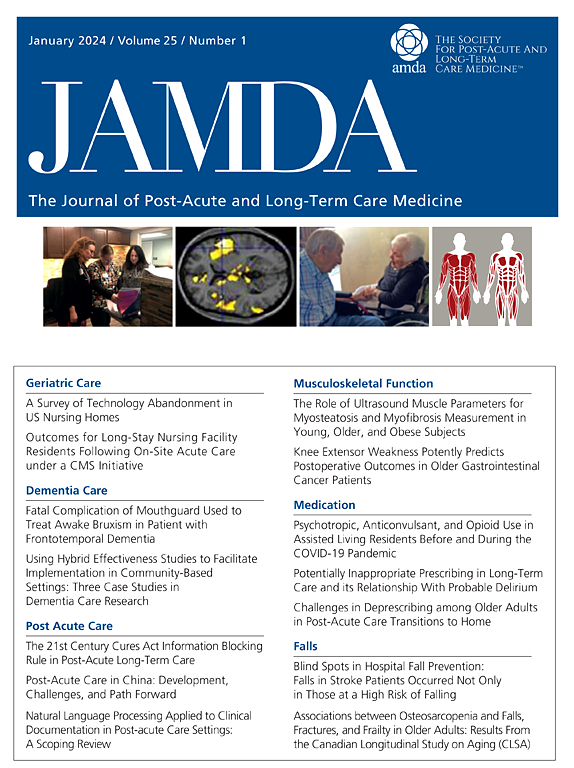Trends in the Use of Medicare Home Health Care among Congregate Living Residents
IF 4.2
2区 医学
Q2 GERIATRICS & GERONTOLOGY
Journal of the American Medical Directors Association
Pub Date : 2025-03-05
DOI:10.1016/j.jamda.2025.105498
引用次数: 0
Abstract
Objective
To examine trends in home health care (HHC) use in congregate living and compare characteristics of HHC use between Medicare patients in congregate living and those in other home settings.
Design
Retrospective cohort study describing HHC use, in and outside of congregate living, using national Medicare claims, assessment, and administrative data (2014-2019). We compared HHC use by setting, on HHC quality, planned visit quantity, referral source (post-acute or community-initiated), and recertifications. We additionally examined whether HHC patterns across settings differed by patient dual eligibility and race-ethnicity.
Setting and Participants
Traditional Medicare (TM) and Medicare Advantage (MA) HHC patients aged 67 and older in congregate living or elsewhere.
Methods
Multivariable regressions.
Results
15.9% of HHC episodes in 2018-2019 were in congregate living, which increased 20.5% between 2014 and 2019. TM patients in congregate living were 4.4% (2.3 ppt, 95% CI: 1.7, 2.9) more likely to use high-quality agencies, had 8.7% (0.7 visits, 95% CI: 0.7, 0.8) more planned visits, were 27.6% (14.9 ppt, 95% CI: 14.7, 15.1) more likely to have community-initiated referrals, and 9.9% (3.2 ppt, 95% CI: 2.9, 3.5) more likely to be recertified compared with TM patients in other settings; differences were similar between settings among MA enrollees. Compared with their counterparts, dually eligible and racial-ethnic minoritized populations in congregate living were 2.6% (−1.5 ppt, 95% CI: −2.2, −0.8%) and 1.6% less likely (−0.9 ppt, 95% CI: −1.6, −0.3%) to use high-quality agencies, respectively, and dually eligible patients in congregate living had 6% fewer planned visits (−0.64 visits, 95% CI: −0.72, −55); these differences persisted across settings.
Conclusion and Implications
Congregate living may have facilitated access to higher quality and quantity of HHC, but inequitably. Further research is needed to determine the value of high-frequency community-initiated HHC referrals in congregate living.
求助全文
约1分钟内获得全文
求助全文
来源期刊
CiteScore
11.10
自引率
6.60%
发文量
472
审稿时长
44 days
期刊介绍:
JAMDA, the official journal of AMDA - The Society for Post-Acute and Long-Term Care Medicine, is a leading peer-reviewed publication that offers practical information and research geared towards healthcare professionals in the post-acute and long-term care fields. It is also a valuable resource for policy-makers, organizational leaders, educators, and advocates.
The journal provides essential information for various healthcare professionals such as medical directors, attending physicians, nurses, consultant pharmacists, geriatric psychiatrists, nurse practitioners, physician assistants, physical and occupational therapists, social workers, and others involved in providing, overseeing, and promoting quality

 求助内容:
求助内容: 应助结果提醒方式:
应助结果提醒方式:


